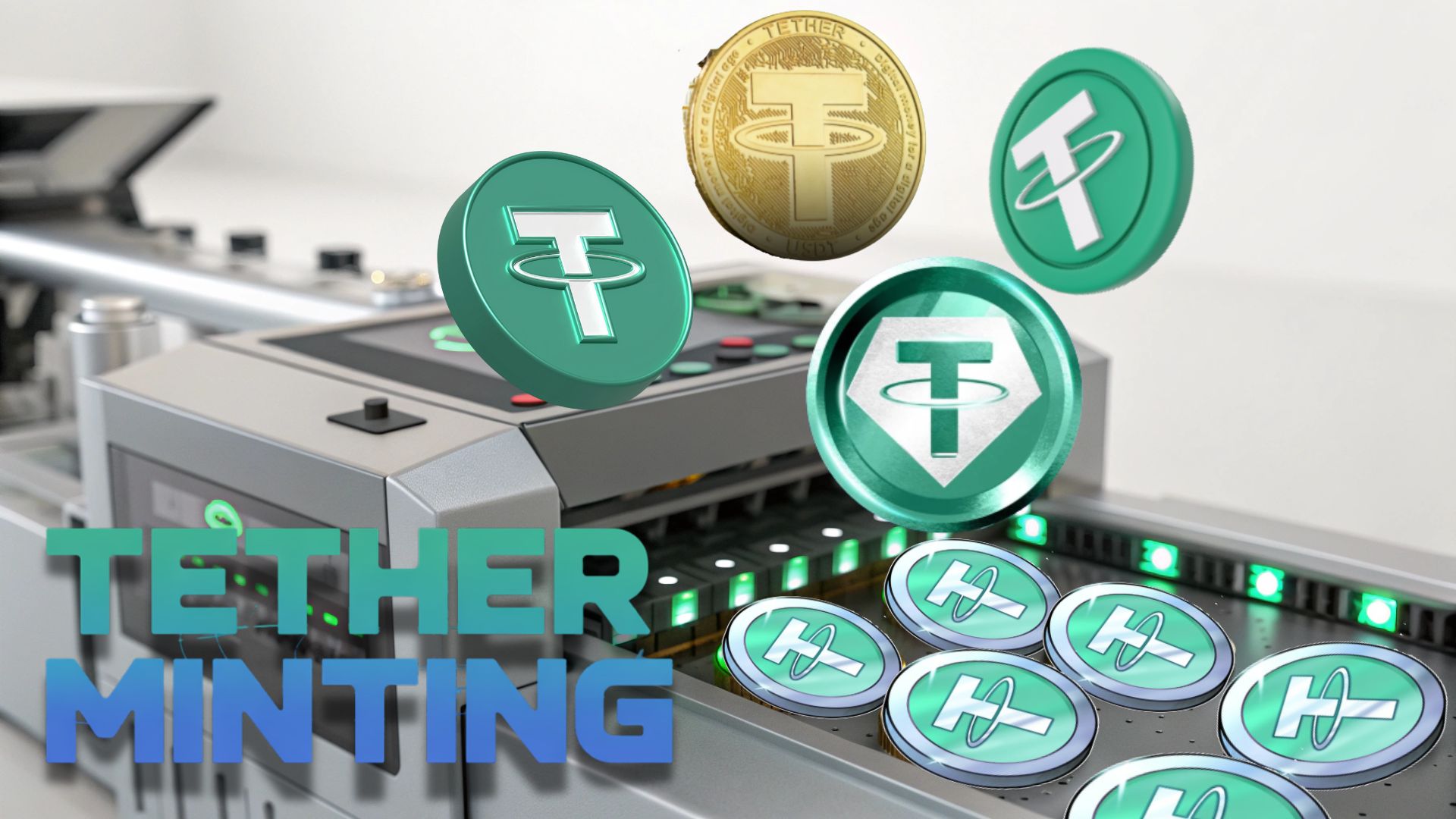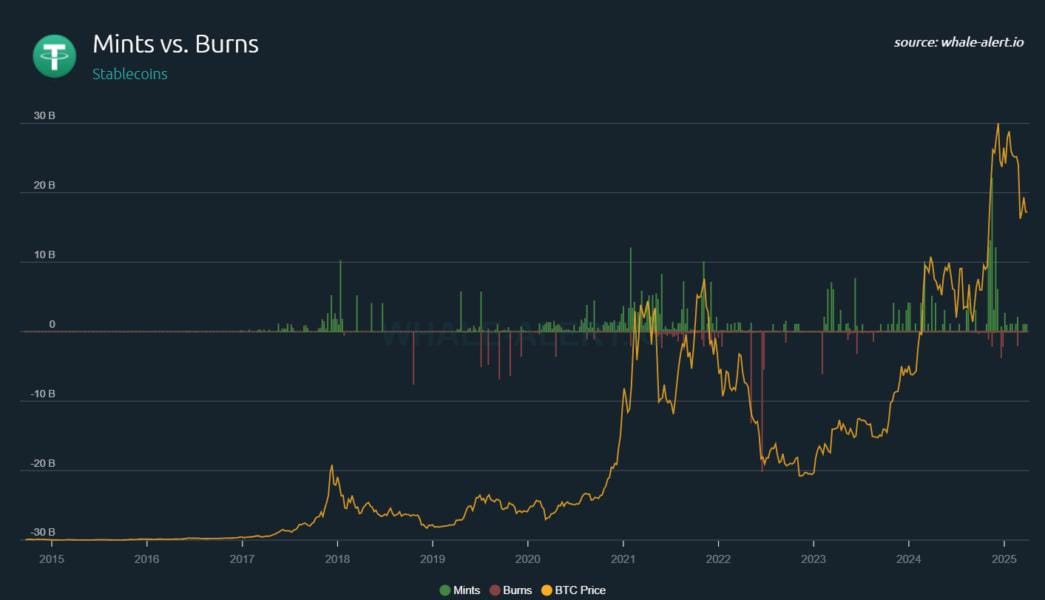- The Crypto Fire
- Posts
- 💸 USDT Minting: Why Tether Prints More Every Time the Market Moves
💸 USDT Minting: Why Tether Prints More Every Time the Market Moves
Uncover how USDT minting works, why new Tether tokens appear during market swings, and what it reveals about crypto liquidity trends.

Table of Contents
Before we dive in, grab this USDT Minting Cheat Sheet—a quick, printable snapshot you can keep open while you read.

⭐ What Is USDT Minting?
$USDT.X ( ▼ 0.01% ) is a digital version of the U.S. dollar, built for blockchain. It’s designed to maintain a 1:1 value with USD, meaning 1 USDT should always equal 1 dollar. Unlike Bitcoin or Ethereum, which can swing wildly in price, USDT stays stable so it is called a stablecoin.
Every USDT token is supposed to be backed by reserves held by Tether Limited, including cash, U.S. Treasury bills, and other liquid assets. This backing gives traders and investors confidence that they can redeem USDT for real-world money whenever they need.
Core Advantages of Using USDT in the Crypto Market
Feature | Description |
|---|---|
Liquidity | It’s the default trading pair across most exchanges. If you buy Bitcoin or sell ETH, chances are you’re using USDT. |
Speed | You can send millions in seconds across blockchains like Tron or Ethereum without relying on banks. |
Accessibility | Available on nearly every major blockchain and exchange, making it easy to move money globally. |
Stability | Shields traders from volatility during market chaos, functioning like digital cash in the crypto world. |
In short, USDT is the digital glue of the crypto economy. It connects centralized exchanges, DeFi protocols, and even payment systems, keeping value stable while the rest of the market swings.
But how does new USDT actually come into existence?
That’s where USDT minting comes in, let’s break it down!
⚙️ How and Where USDT Minting Happens
While the Federal Reserve manages money creation and prints USD via the Bureau of Engraving and Printing, in the crypto world, liquidity comes from minting USDT by Tether.
USDT Minting is the process of generating new USDT tokens and putting them on the blockchain.
This happens when verified clients, typically exchanges, institutional traders, or market makers, deposit fiat currency (like USD or EUR) into Tether’s bank accounts.
Once Tether confirms receipt of the funds, it mints an equivalent amount of USDT on one or more blockchains and sends it to the client’s wallet.

This mint-and-burn cycle ensures that the total USDT supply always reflects real market demand and actual collateral in reserve.
Multi-Chain Minting
USDT isn’t tied to one blockchain. It’s a multi-chain stablecoin operating on over 15 networks, with the most active being:
Ethereum (ERC-20): The most established chain, preferred for institutional transactions and DeFi integrations.
Tron (TRC-20): The go-to network for fast and cheap transfers — now hosting over 60% of all USDT supply.
Solana: Popular for its high-speed capabilities in DeFi and trading bots.
Avalanche, Polygon: Smaller but growing ecosystems that expand Tether’s reach.
Each chain has its own Tether smart contract, where minting and burning are fully transparent and verifiable on-chain. For example, when $500 million in USDT is minted on Tron, it instantly appears in the public TRC-20 contract, visible to anyone.
In short, USDT minting is how crypto gets fresh liquidity. It’s not random, it’s a reflection of demand. And when you see it spike, it’s usually a sign the market is gearing up for something big.
⚖️ Why Does USDT Minting Spike During Market Volatility?
When volatility hits, traders, exchanges, and institutions all react simultaneously. Exchanges need more liquidity to handle the spike in trading volume.
Market makers require larger stablecoin reserves to rebalance their portfolio and execute orders efficiently.
Institutional investors want fast access to capital to either buy or protect their positions.
→ Together, these pressures lead to increased USDT minting.
Tether(@Tether_to) just minted 1B $USDT again!
#Tether and #Circle have minted $4.5B in stablecoins after the market crash.
etherscan.io/address/0xc6cd…
solscan.io/account/7VHUFJ…— Lookonchain (@lookonchain)
8:18 AM • Oct 15, 2025
Here are the four main reasons behind those minting spikes:
1. Fuel for Bull Runs
In strong uptrends, investors rush to buy crypto assets as prices rise. Exchanges must quickly expand their liquidity pools to accommodate this influx of buyers.
To keep markets fluid, Tether mints new USDT, ensuring there’s enough stablecoin supply across networks like Ethereum and Tron. This newly issued USDT then flows into exchanges, where it powers new trading activity and helps maintain smooth order books as demand surges.
2. Protection During Bear Markets
When the market crashes, traders don’t want to hold risky coins like Bitcoin $BTC.X ( ▼ 3.11% ) or Ethereum $ETH.X ( ▼ 2.06% ) anymore. Hence, they rush to safety by transferring to stablecoins.
This move to stability brings fresh money into the system. Big investors and exchanges send fiat to Tether, which then mints new USDT to keep things liquid.
3. “Buying the Dip” Liquidity
For experienced traders and institutional desks, crashes are moments to accumulate discounted assets. To act fast, they need stable, on-chain capital ready to deploy.
Investors deposit fiat directly with Tether, receive newly minted USDT, and push it into exchanges. This mechanism often precedes market rebounds, serving as an early sign of capital re-entering the market.
4. Preemptive Liquidity Preparation
Not all newly minted tokens go straight into circulation. Tether often mints “authorized but not issued” USDT, in which tokens are held in reserve for potential liquidity needs.
These standby tokens are ready to be deployed when exchanges or institutional partners need rapid access during turbulent periods.
In short, USDT minting isn’t just about printing more tokens, it’s the system’s natural response to liquidity stress. During bull runs, it fuels trading activity. During crashes, it stabilizes the system. And in every cycle, it keeps the market’s engine running, balancing greed, fear, and capital flow across the entire crypto economy.
🚀 Other Major Stablecoins and How They Work
While USDT minting dominates the headlines, it’s not the only game in town. The crypto market today is filled with different stablecoins, each backed by unique mechanisms and managed by different organizations.
Let’s look at the biggest ones:
Stablecoin | Issuer / Company | Backing Mechanism | Key Networks | Special Note |
|---|---|---|---|---|
USDT $USDT.X ( ▼ 0.01% ) (Tether) | Tether Limited | Backed by USD reserves, short-term U.S. Treasury bills, and secured loans. | Ethereum, Tron, Solana, Avalanche, Polygon, etc. | The most widely used and liquid stablecoin; centralized issuance with on-chain transparency for minting and burning. |
USDC $USDC.X ( ▼ 0.01% ) (USD Coin) | Circle & Coinbase (via Centre Consortium) | Fully backed by cash and short-term Treasuries; monthly attestations by auditors. | Ethereum, Solana, Base, Avalanche, Polygon. | Known for strong regulatory compliance and transparency, often preferred by U.S.-based institutions. |
DAI $DAI.X ( ▲ 0.01% ) (MakerDAO) | MakerDAO (DeFi protocol) | Overcollateralized by crypto assets like ETH, WBTC, and USDC. | Ethereum, Layer 2 networks (Arbitrum, Optimism). | Decentralized stablecoin — no single company controls supply; minting occurs through smart contracts. |
FDUSD $FUSD.X ( ▲ 0.01% ) | First Digital Labs (Hong Kong) | Fully backed by fiat reserves and cash equivalents. | Binance Smart Chain, Ethereum. | Gaining traction as Binance’s preferred stablecoin after BUSD phase-out. |
TUSD $TUSD.X ( ▼ 0.04% ) (TrueUSD) | Archblock (formerly TrustToken) | Backed by escrowed USD reserves with real-time audits. | Ethereum, Tron, BNB Chain. | One of the first to introduce transparent on-chain reserve data feeds. |
⭐ Key Takeaways
USDT minting is the heartbeat of crypto liquidity. Every time new USDT is created, it is a signal of capital flowing in, traders preparing, and markets adjusting to volatility. Whether it’s funding bull runs or stabilizing crashes, minting reflects real demand and ensures exchanges never run dry of usable capital. It’s not random inflation; it’s how digital liquidity responds to market stress in real time.
USDT and other stablecoins form the backbone of the digital economy. Whether centralized or decentralized, their minting mechanisms all serve the same purpose, which is to keep liquidity flowing and value stable in an unpredictable market. USDT may dominate, but other stablecoins are rising too, such as USDC, TUSD, FUSD.
Rate us today!Your feedback helps us improve and deliver better Crypto content! |





Reply